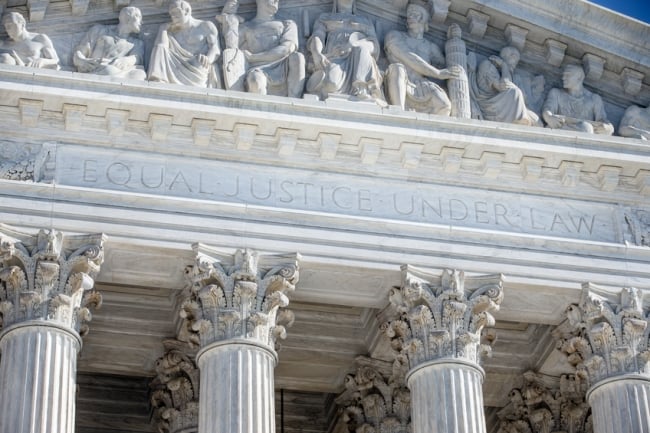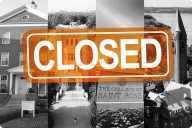You have /5 articles left.
Sign up for a free account or log in.

Getty Images
Experts always warn against predicting the outcome of U.S. Supreme Court decisions on the basis of the questions the justices ask during hearings.
But in arguments before the Supreme Court today, justices with a history of opposing affirmative action—or new justices expected to oppose affirmative action—asked questions that reflected skepticism about the practice. The comments below are from the hearing on the affirmative action plan of the University of North Carolina at Chapel Hill, the first of the arguments on today’s docket. This article will be updated later with the arguments about Harvard University’s policies and practices.
For instance, Justice Clarence Thomas said of diversity, “I don’t have a clue what it means.”
And he rejected the answer from Ryan Park, who was defending UNC, about the educational benefits of diversity. Thomas said he didn’t “put much stock in that.”
When the U.S. solicitor general, Elizabeth B. Prelogar, said the U.S. service academies practice affirmative action in admissions because the military needs a diverse population, Justice Thomas asked his question again.
Justice Amy Coney Barrett asked about affinity group housing for Black students and their supporters, even as she acknowledged that UNC Chapel Hill doesn’t offer such housing.
Justice Neil M. Gorsuch posed a hypothetical: What about colleges that could have a diverse student body solely by eliminating preferences for legacy applicants, the children of donors or squash players?
And several justices addressed the question of how long affirmative action should be needed. When Sandra Day O’Connor was a justice, she wrote in a 2003 affirmative action case that she imagined it would not be necessary in 25 years. When Justice Barrett asked Park about it, he said, “I think it’s a dial, not a switch,” and that UNC has already “dialed it down.”
Prelogar said, “I do think eventually” affirmative action will end in higher education.
Chief Justice John G. Roberts said to Park, “I don’t know how you can say the program will ever end. You’re always going to have to look at race because you say race matters.”
Justice Gorsuch also asked about reports that Asian applicants are told by many college counselors to hide their race when they are applying.
And Justice Samuel A. Alito Jr. asked about whether a college’s definitions of race could be “so broad” that they are unconstitutional. He asked why a student from Afghanistan is considered Asian in the same way as students descended from Chinese immigrants.
Three justices—Ketanji Brown Jackson, Elena Kagan and Sonia Sotomayor—asked questions that suggested support for affirmative action.
Justice Jackson (who has recused herself from the Harvard case) presented a hypothetical situation on two students applying to UNC. Both had been in North Carolina “for generations—since before the Civil War,” and it was important to both of them to honor their family legacies by attending the university.
The first applicant noted that he would be the fifth generation to graduate from UNC. The second applicant noted that his family members were enslaved and had never had a chance to attend UNC.
“Now, as I understand your ‘no race-conscious admissions rule,’ these two applicants would have a dramatically different opportunity to tell their family stories and to have them count,” Jackson said. “The first applicant would be able to have his family background considered and valued by the institution as part of its consideration of whether or not to admit him, while the second one wouldn’t be able to because his story is in many ways bound up with his race and with the race of his ancestors.”
A Chance to Reverse Course
The cases represent a chance for opponents of affirmative action to reverse not only the Harvard and UNC decisions but many others that have upheld the use of affirmative action since the Supreme Court ruled in the Bakke case in 1978.
The composition of the Supreme Court differs significantly from the last time it upheld the use of affirmative action in college admissions, in 2016, in a case involving the University of Texas at Austin.
That decision was 4 to 3 because of the death of Justice Antonin Scalia, an opponent of affirmative action, and the recusal of Justice Kagan, who worked on the case as solicitor general before she joined the Supreme Court. The author of the decision, Justice Anthony M. Kennedy, has since retired from the Supreme Court.
The three justices who were in the minority in that case—Chief Justice Roberts, Justice Alito and Justice Thomas—remain on the court, and they have been joined by three conservative justices.
The Harvard case decisions—in 2019 by Judge Allison Burroughs and in 2020 by the U.S. Court of Appeals for the First Circuit—came in a much-watched case brought by a long-standing critic of affirmative action on behalf of a group of Asian American plaintiffs.
“For purposes of this case, at least for now, ensuring diversity at Harvard relies, in part, on race conscious admissions,” Burroughs wrote in her conclusion. “Harvard’s admission program passes constitutional muster in that it satisfies the dictates of strict scrutiny. The students who are admitted to Harvard and choose to attend will live and learn surrounded by all sorts of people, with all sorts of experiences, beliefs and talents. They will have the opportunity to know and understand one another beyond race, as whole individuals with unique histories and experiences.
“It is this, at Harvard and elsewhere that will move us, one day, to the point where we see that race is a fact, but not the defining fact and not the fact that tells us what is important, but we are not there yet. Until we are, race conscious admissions programs that survive strict scrutiny will have an important place in society and help ensure that colleges and universities can offer a diverse atmosphere that fosters learning, improves scholarship, and encourages mutual respect and understanding.”
The appeals court said, “The issue before us is whether Harvard’s limited use of race in its admissions process in order to achieve diversity in the period in question is consistent with the requirements of Supreme Court precedent. There was no error.”
Students for Fair Admissions, the group that sued Harvard, in February asked the Supreme Court to hear the case. The brief asked the Supreme Court to repeal its 2003 decision in Grutter v. Bollinger, which upheld the use of affirmative action in admissions by the law school at the University of Michigan. “Although Grutter praised the ‘educational benefits’ of student body diversity writ large, its assumption that a university can predict, based solely on race, an applicant’s ‘views’ or ‘experience[s]’ is little more than racial stereotyping.”
With regard to Harvard, the Students for Fair Admissions brief said, “At Harvard, race is not a ‘plus’ that is always ‘beneficial’; it’s a minus for Asian Americans. At Harvard, race is not a ‘factor of a factor of a factor’; it is an anvil on the scale that dominates the entire process. At Harvard, race is not a ‘temporary’ evil to be repealed as soon as possible; it is a key aspect of identity that Harvard will use until a court makes it stop.”
The UNC Case
UNC won the case a year ago when Judge Loretta C. Biggs found that “at trial, UNC defendants produced substantial, credible, and largely uncontested evidence that it has made the deliberate decision to pursue the educational benefits that flow from student body diversity; has offered a principled, reasoned explanation for this decision; and that the benefits the university seeks to achieve are sufficiently measurable to permit judicial scrutiny.”
Normally, the plaintiffs in the case, Students for Fair Admissions, would appeal to the U.S. Court of the Appeals for the Fourth Circuit. But SFFA said that, given the similarities to the Harvard case, the Supreme Court should combine the two cases.








